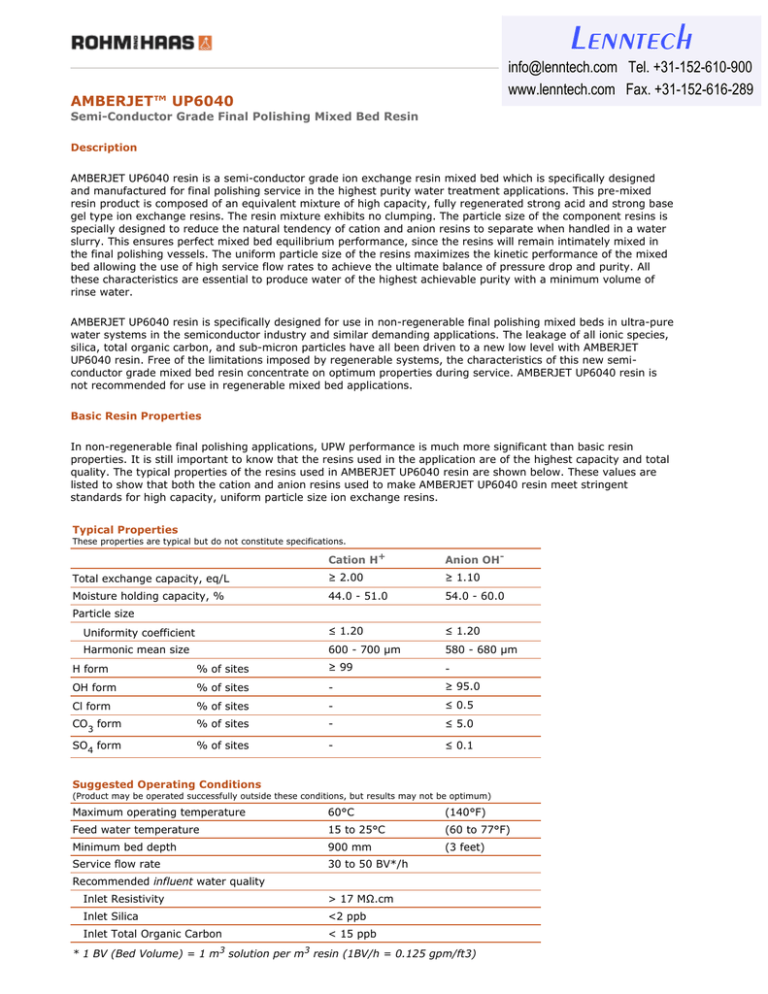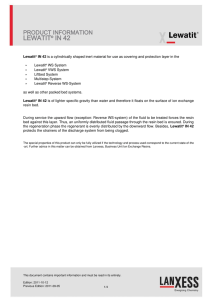
Lenntech
info@lenntech.com Tel. +31-152-610-900
www.lenntech.com Fax. +31-152-616-289
AMBERJET™ UP6040
Semi-Conductor Grade Final Polishing Mixed Bed Resin
Description
AMBERJET UP6040 resin is a semi-conductor grade ion exchange resin mixed bed which is specifically designed
and manufactured for final polishing service in the highest purity water treatment applications. This pre-mixed
resin product is composed of an equivalent mixture of high capacity, fully regenerated strong acid and strong base
gel type ion exchange resins. The resin mixture exhibits no clumping. The particle size of the component resins is
specially designed to reduce the natural tendency of cation and anion resins to separate when handled in a water
slurry. This ensures perfect mixed bed equilibrium performance, since the resins will remain intimately mixed in
the final polishing vessels. The uniform particle size of the resins maximizes the kinetic performance of the mixed
bed allowing the use of high service flow rates to achieve the ultimate balance of pressure drop and purity. All
these characteristics are essential to produce water of the highest achievable purity with a minimum volume of
rinse water.
AMBERJET UP6040 resin is specifically designed for use in non-regenerable final polishing mixed beds in ultra-pure
water systems in the semiconductor industry and similar demanding applications. The leakage of all ionic species,
silica, total organic carbon, and sub-micron particles have all been driven to a new low level with AMBERJET
UP6040 resin. Free of the limitations imposed by regenerable systems, the characteristics of this new semiconductor grade mixed bed resin concentrate on optimum properties during service. AMBERJET UP6040 resin is
not recommended for use in regenerable mixed bed applications.
Basic Resin Properties
In non-regenerable final polishing applications, UPW performance is much more significant than basic resin
properties. It is still important to know that the resins used in the application are of the highest capacity and total
quality. The typical properties of the resins used in AMBERJET UP6040 resin are shown below. These values are
listed to show that both the cation and anion resins used to make AMBERJET UP6040 resin meet stringent
standards for high capacity, uniform particle size ion exchange resins.
Typical Properties
These properties are typical but do not constitute specifications.
Cation H+
Anion OH-
Total exchange capacity, eq/L
≥ 2.00
≥ 1.10
Moisture holding capacity, %
44.0 - 51.0
54.0 - 60.0
Uniformity coefficient
≤ 1.20
≤ 1.20
Harmonic mean size
600 - 700 µm
580 - 680 µm
-
Particle size
H form
% of sites
≥ 99
OH form
% of sites
-
≥ 95.0
Cl form
% of sites
-
≤ 0.5
CO3 form
% of sites
-
≤ 5.0
SO4 form
% of sites
-
≤ 0.1
Suggested Operating Conditions
(Product may be operated successfully outside these conditions, but results may not be optimum)
Maximum operating temperature
60°C
(140°F)
Feed water temperature
15 to 25°C
(60 to 77°F)
Minimum bed depth
900 mm
(3 feet)
Service flow rate
30 to 50 BV*/h
Recommended influent water quality
Inlet Resistivity
> 17 MΩ.cm
Inlet Silica
<2 ppb
Inlet Total Organic Carbon
3
< 15 ppb
3
* 1 BV (Bed Volume) = 1 m solution per m resin (1BV/h = 0.125 gpm/ft3)
Quality Assurance
AMBERJET UP6040 resin is tested by Rohm and Haas for resistivity, TOC, and kinetic performance. This insures
that all batches of AMBERJET UP6040 resin will meet stringent UPW performance requirements on these most
critical parameters.
Rohm and Haas will fully support the quality and performance of AMBERJET UP6040 resin in UPW applications in
order to assure full customer satisfaction that the delivered product is of the highest quality.
Typical TOC and resistivity curves based on our quality control procedure for AMBERJET UP6040 resin are shown
below.
Resistivity and TOC Rinse Performance
All our products are produced in ISO 9001 certified manufacturing facilities.
AMBERJET is a trademark of Rohm and Haas Company and its affiliates, Philadelphia, U.S.A.
Ion exchange resins and polymeric adsorbents, as produced, contain by-products resulting from the manufacturing process. The user must
determine the extent to which organic by-products must be removed for any particular use and establish techniques to assure that the
appropriate level of purity is achieved for that use. The user must ensure compliance with all prudent safety standards and regulatory
requirements governing the application. Except where specifically otherwise stated, Rohm and Haas Company does not recommend its ion
exchange resins or polymeric adsorbents, as supplied, as being suitable or appropriately pure for any particular use. Consult your Rohm and
Haas technical representative for further information. Acidic and basic regenerant solutions are corrosive and should be handled in a manner
that will prevent eye and skin contact. Nitric acid and other strong oxidising agents can cause explosive type reactions when mixed with ion
exchange resins. Proper design of process equipment to prevent rapid buildup of pressure is necessary if use of an oxidising agent such as
nitric acid is contemplated. Before using strong oxidising agents in contact with ion exchange resins, consult sources knowledgeable in the
handling of these materials.
Rohm and Haas Company makes no warranties, either expressed or implied, as to the accuracy or appropriateness of these data, and
expressly excludes any liability upon Rohm and Haas arising out of its use. We recommend that the prospective users determine for
themselves the suitability of Rohm and Haas materials and suggestions for any use prior to their adoption. Suggestions for uses of our
products or the inclusion of descriptive material from patents and the citation of specific patents in this publication should not be understood
as recommending the use of our products in violation of any patent or as permission or license to use any patents of the Rohm and Haas
Company and its affiliates. Material Safety Data Sheets outlining the hazards and handling methods for our products are available on
request.
©Rohm and Haas, 2007
All rights reserved.
April 2007
PDS 0624 A – Apr. 07 - 2/2

